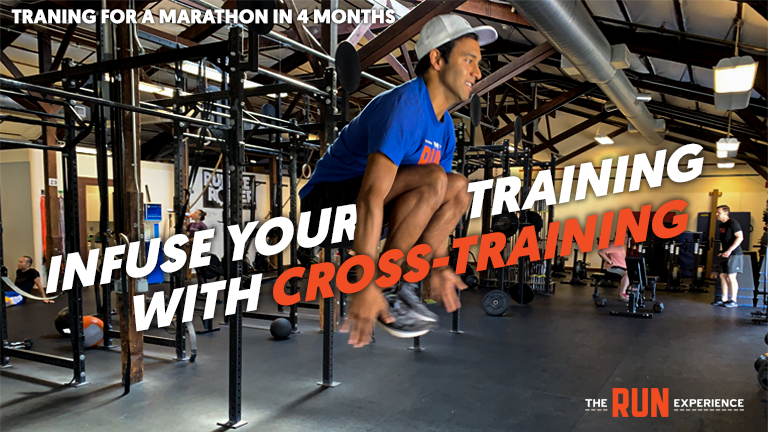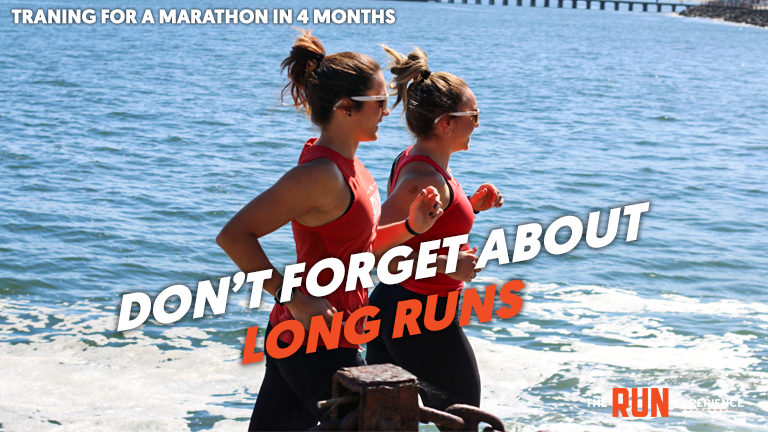4-Month Marathon Training Plan for Beginners
Use our 4-month marathon training plan to get in tip-top shape and condition for your marathon race in 16 weeks or less.

Eyeing a marathon that’s 16 weeks away? We can show you how to train for a marathon in 4 months or less—though, more time is always better when it comes to improving your pace and reducing your risk of injury. Our 4-month marathon training plan has all the scheduling, tips, and know-how you need to succeed.
Many long-distance runners have the ultimate goal of running a marathon for the first time. While it’s certainly a major accomplishment, being able to train for a marathon doesn’t have to take forever.
No matter what, our marathon training program can have you ready, confident, and excited to reach the finish line on race day. 16 weeks might not “feel” like a lot of time, but if you use it wisely with the coaching experts in our training program, you’ll be there faster (and stronger) than you think!
4-Month Marathon Training Plan
Whether you’ve trained for a half marathon before or not, you can still do a full marathon first. Our program is based on strength work, specific training runs, weekly long runs, cross-training, nutrition, and correct form and posture.
Each day of the week will have a specific focus throughout the training plan. The workouts will change some over time as you progress towards race day. For example, some weeks you will lower your training volume a little bit to help you recover from intense periods of training, and you’ll go through a “tapering” period to help your body feel rested before you hit the starting line.
Keep in mind, though, no matter where you are as a runner today, you can be ready in just four months! Here’s what you’d expect in a general week:
Mondays: Core Work and Restoration Training
On Mondays, it’s all about focusing on new movements with increasingly challenging volume and core workout sets. We’ll focus on improving your running posture and being able to hold it for longer periods of time–so you can expend more energy by running as efficiently as possible.
We’ll also pay special attention to your breathing mechanics, so you can get the most out of each breath when it counts. This workout should take about 45 minutes.
Want to know more about core work and how it can help your running? Check out this 10-minute core video from TRE Coach Holly:
Tuesdays: Posture, Breathing, and Pulling Drills
This workout for marathoners will focus on three different drills that we introduced in all our training programs. You’ll start with a quick warm up featuring belly breaths and a 10-minute run where you connect your breathing with your running cadence.
The main drills you’ll focus on next are the leg swing, pulling, and running as tall and relaxed as possible. The total workout of running plus drills will take about 20-40+ minutes.
Want to learn more about breathing tips for running and racing that will help you train for a marathon? Try this video from Coach Nate:
Wednesdays: Strength and Cross-Training
Wednesdays come packed full of strength training that will foster more stable hips and shoulders–and how it translates into better running form. It also includes cross-training that will make you stronger and give your legs a break from all the pounding, as anyone who is training for their first marathon experiences.
The workout takes about 45 minutes and includes a warm up consisting of three 10 rounds of seconds of jogging in place, followed by three rounds of 10 seconds of butt kicks, with 10 seconds of rest in between. You’ll also do three rounds of lateral lunge and hip circles, and two rounds of opposite arm circles.

The main workout will look something like this each week:
- Three rounds of walking lunges and forwards bear crawl
- Three rounds of inchworms and backwards bear crawl
- Three rounds of single-leg burpees and 10 step-ups per leg
- Three rounds of 10 shoulder touch push-ups and 10 box jumps
You’ll finish up with ten minutes of quad rolling and thoracic spine stretching and call it a day!
Thursdays: Hill Intervals

Get ready to hit the hills for speedwork and strength on Thursdays. Why are they so important? Hills build running strength, improve form and technique when you train for a marathon.
They also help us increase our running cadence for powerful, efficient running. Ankle, hip, and shoulder mobility improve with hill running, too! Here’s what a typical hill workout may look like:
- A warm up with 10 belly breaths to prepare for an intense workout
- A slow 10-minute jog to get your muscles warmed up, focusing on running tall and light
- One round of 10 sprawls, 10 squats, 10 hip circles per leg, 10 elbow touches per side, and 10 leg swings–you should be good and warmed up!
- Depending on where you are in the 16-week training plan, you’ll run 5-10 60-90 second hills. Find about a five percent incline, or use an indoor treadmill. Jog down the hill for about one to two minutes of rest between each hill. End with a 10-minute cool down jog and light stretching. This workout should take about 30 minutes to an hour, depending on what week you’re on. Now, let’s check out this video on three hill running tips for stronger running:
Fridays: Rest Day, Nutrition, and Mobility
You’ve packed a lot of work into four days so far this week. On Fridays, we’ll focus on rest, nutrition, and becoming more mobile. The goal is to provide a mental and physical break to recover–and prepare to stay with your training plan. While working hard is important, it’s just as important to give your body the chance to recover, rest, and reduce the risk of injury.
Rest, but also focus on working/stretching out those tight areas. For example, use a foam roller on those tight calves and quads!
As far as proper nutrition goes for running recovery, check out this video from the awesome distance runner, Dathan Ritzenhein:
Saturdays: The Distance Run
Like most runners training for an important race, you probably fall into one of two categories when it comes to longer distances–you love it…or it’s your least favorite. If you love speed work such as tempo runs, you probably fall into the latter category.

However, it’s a critical part of your marathon training! It teaches you how to pace, how to get used to the distance of a long race, and how to handle your nutrition needs on a longer run. Here’s what a typical long run workout may look like, depending on your training week and your current weekly mileage:
- Start with 10 minutes of light jogging where you focus on your breathing
- Do one round of leg swings, lunges, hip circles, and inchworm push-ups
- On your first week, run five to seven miles at an easy, conversational pace. In later weeks, you’ll build up to about 20 miles to get you ready for the big day.
- Remember, this run is about distance, not pace. You should be easily able to talk during this run, not gasping for breath!
Sundays: Fun Run and Cross Training Day
This is your day to have fun with your running and remember why you fell in love with the sport in the first place. After all, all of your marathon training schedule doesn’t have to be serious business.
So today, it’s up to you. If that means a game of soccer with friends, riding a bike, or playing tennis with a buddy, go for it. There’s only one rule–have fun!
Injury Prevention Tips for 16-Week Marathon Training Plans
The biggest obstacle you'll have to overcome with any 16-week marathon training plan is injury. Trying to smoosh in a big amount of training always increases your risk of injury, but there are steps you can take to mitigate this risk:
1. Choose the Right Footwear
Selecting the appropriate running shoes is crucial for injury prevention. The right shoes provide the necessary support and accommodate your specific foot type and running style, reducing the risk of common injuries. A visit to a specialty running store for professional gait analysis is highly recommended to ensure the best shoe choice.
2. Listen to Your Body
Attentiveness to your body's signals is key in preventing injuries. If you experience any unusual pain, fatigue, or discomfort, it's a sign to ease up. Ignoring these signs can lead to more serious injuries, so rest and seek medical advice if needed.
3. Incorporate Rest Days
Rest days are essential in any training plan. They allow your body to recover and repair, reducing the risk of overuse injuries. Make sure to schedule rest days, especially following long runs or intense workouts, to facilitate muscle recovery and maintain overall health.
4. Gradual Progression
A gradual increase in training intensity and mileage is critical to avoid overtraining and injury. Increasing your weekly mileage by no more than 10% helps your body adapt safely to the increased physical demands of marathon training.
5. Strength Training and Core Work
Strength and core exercises are vital for a well-rounded training regimen. Strengthening your core and leg muscles improves your running form and efficiency, which can significantly reduce the likelihood of injuries.
6. Proper Warm-Up and Cool-Down
Always start your runs with a proper warm-up and end with a cool-down. A warm-up prepares your muscles and joints for the run, while cool-down stretches aid in recovery and flexibility, reducing post-run muscle stiffness.
7. Hydration and Nutrition
Nutrition and hydration play a significant role in injury prevention. Maintaining a balanced diet and ensuring adequate hydration, especially on long runs, are crucial for your body's health and resilience during training.
8. Cross-Training
Incorporating low-impact activities like cycling, swimming, or yoga can greatly benefit your marathon training. Cross-training enhances overall fitness while giving your primary running muscles a necessary break, aiding in injury prevention.
Start Your 4-Month Marathon Training Plan
Ok, so now you know about the structure of TRE’s marathon training plan and that you can be ready in just four months, aren’t you ready to lace up your running shoes and train for a marathon?
Sign up for our marathon training program today for day-by-day workout guides, expert advice, videos, training tips, and more!
